#343 Mudgirls Manifesto
August 14th, 2018

Mudgirls Manifesto: Handbuilt Homes Handcrafted Lives
Authored by the Mudgirls Natural Building Collective
New Society Publishers (2017)
$29.99
978-0-86571-877-7
Review by Kate Braid
I was excited about being asked to review this book. In the ’70s and ’80s I spent 15 years as a Red Seal Journey(wo)man Carpenter building and renovating houses, high-rises and bridges, and later wrote poetry and non-fiction about the experience. What could be more perfect than reviewing a book about women building?
But this book wasn’t what I’d expected – or not exactly. Yes, it’s about women building, but the first hundred pages are more about manifesto than mud.
The Mudgirls Natural Building Collective was started on Lasqueti Island, an isolated island off the coast of central British Columbia, by Jen Gobby in 2004 as a hands-on solution to finding affordable, environmentally-friendly housing. It started as The Mudgirls Bartering Collective, and the current (wage-earning) collective formed three years later as an all-women group, though it has included some men.
The fact that it’s primarily a group of women is essential to their philosophy as well as their practice, and I deeply understood this pleasure in working with other women. The first time I worked with a woman in construction after five years of working exclusively with men, was a revelation. With a woman, I didn’t have to prove myself over and over. I could openly express my delight in a wall well-built, a problem solved, could talk about personal things like relationships, not just cars and sports.
The Mudgirls discovered the same – and more. “In more ways than we even realized at the time,” they explain, “we effectively side-stepped the baggage and bullshit of justifying our skills and our existence, by entirely inventing our own arena of work…. Nobody could tell us we weren’t doing it right, because we were the only ones around doing it.” (p.38-39, parag.4)
This was familiar; I’ve been in my share of feminist marches and consciousness-raising groups, arguing endlessly for women’s right to equal treatment, particularly the right to build. Before becoming active in the trade union and feminist movements, I lived in a rural commune that questioned traditional values and relationships. So why, as I dived into the Mudgirls Manifesto, was I feeling, at moments, ambiguous, even alarmed?
It was partly the forthrightness of their stance; the Mudgirls are upfront about their politics and philosophy about living and building, and very clear that capitalism is the culprit. “Our freedom to choose how we live our lives is kidnapped,” they assert, “forcibly wrapped up in this plastic capitalist mind-set, and tossed out, regarded as irresponsible and a little bit crazy.” (p.24, parag. 1.) I haven’t heard people ringing such clear capitalist alarm bells for a long time! The Mudgirls set out to build – they repeat it often – “a true alternative community that encompassed not just providing shelter, but food, feminism, environmentalism, and community.” (p.38, paragraph 1)
“The Mudgirls are building a Revolution!” one of their clients proclaims (p.106, parag.1).
So, what might a Mudgirl revolution look like? For one thing, many of the women are young mothers, so free childcare is considered essential and is built into all their workshops, meetings (of which there are many), and time spent actually building.
I was trained to build by the book – literally, the Building Code book that sets provincial standards for building including requirements for spacing support posts and beams, the strength of concrete, electrical, plumbing and all other aspects of building. Though the Mudgirls make some gestures toward the Building Code, they also brag about the fact that they can slip under the radar because one of their main building materials – cob – is not yet part of the BC Building Code (p.36, parag.3). My unease increased when I read on page 21: “Not to say we don’t often collaborate on projects that are fully code and/or engineer approved – we do so all the time. But what really gets our hearts pumping is figuring out how to do things according to good sense and natural laws, not according to capitalist logic.” (p.21, parag. 2.) You mean, they don’t build by the Building Code? There’s even a section here on why cob walls (built of fine sand with straw and clay as the mortar) fall down. Are these Mudgirls and their clients not alarmed?
Well, yes, but just a little. They acknowledge that walls falling is the most dangerous thing that can happen at a building workshop (though I wondered: what about people falling off roofs? ladders? cutting off body bits with saws and chisels?) Yet they end this section with “a wall fall play list,” that includes tunes for your walls to fall down to, like Bastille’s “Pompeii.” (p.155, parag. 3) This kind of “gee-whiz” enthusiasm felt naïve at best, dangerous at worst, and yet….
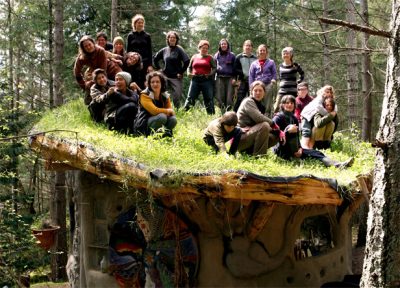 From women who aren’t afraid to use the words “capitalist” and “alternative” and “new roles in society” – “love,” even – in the context of building, there’s an exuberance and joy in the text as well as in the faces in the many photographs, that I, as another builder, deeply understand. It was the first thing I loved about construction – the joy that comes from physical labour, the fact that building lets us see the “direct results of our actions.” (p.67, parag. 1) This is the deep satisfaction of women building shelter for others. It is a pleasure we women are rarely allowed to find out for ourselves. For Mudgirls, the physical fact that every stick and handful of mud in the emerging house has to be “pulled, dug, cut peeled, barrowed, or carried up to the house site,…. sounds like fun, like freedom, like something worth doing.” (p. 67, parag. 1) Indeed!
From women who aren’t afraid to use the words “capitalist” and “alternative” and “new roles in society” – “love,” even – in the context of building, there’s an exuberance and joy in the text as well as in the faces in the many photographs, that I, as another builder, deeply understand. It was the first thing I loved about construction – the joy that comes from physical labour, the fact that building lets us see the “direct results of our actions.” (p.67, parag. 1) This is the deep satisfaction of women building shelter for others. It is a pleasure we women are rarely allowed to find out for ourselves. For Mudgirls, the physical fact that every stick and handful of mud in the emerging house has to be “pulled, dug, cut peeled, barrowed, or carried up to the house site,…. sounds like fun, like freedom, like something worth doing.” (p. 67, parag. 1) Indeed!
The anti-capitalist, revolutionary flag is flown for several more chapters so I was grateful to learn, toward the middle of the book, how the collective actually works. The women “challenge the capitalist paradigm of business” (p.2, parag.4) by keeping wages lower than market value, practicing barter and training others in the skills of building with mud. That means the “workshops” they lead, each of about 20 people, are actual building opportunities. The people who sign up tend to be young people without a lot of cash who pay $500 per week for the opportunity to work on someone else’s house – and incidentally learn how to build their own. Only the Mudgirl who is workshop leader for that job gets paid, as do the cook and childcare worker. The owner of the property in fact gets free labour – labour that is in effect, paying for the privilege of learning to build. “And therein lies its awesomeness!” enthuses the Manifesto. (p.121, parag.3)
These women largely avoid machines and electrical tools. They specify that the point of their work is not speed (which it specifically is in traditional building) but “about the people building something themselves… all while not having to yell over the sound of loud machines.” (p.65, parag. 2, p.66, parag.1). And in fact, after several years in construction I realized that one of the reasons men talk so little on the job is very much for this reason: that you can’t hear each other over the roar of skill saws and the clacking of cranes.
But when you’re using heavy raw materials like mud, clay, sand and water – lots of water – but a minimum of heavy machinery, then strength becomes an issue. In fact, the oft-repeated reason for excluding women from construction entirely until the 1970s, was that we weren’t strong enough. With the support of new Human Rights laws that gave women at least a chance to try, women’s answer was, “If I can’t do it alone, I’ll ask for help.” And that’s exactly what the Mudgirls do; they help each other. “We had nothing to prove, at least not on the muscular side of things,” they write. “What we had to prove was that we did things differently.” (p.43, parag.3) As they put it, “We’ve learned that brute force would not solve too many of our building obstacles. We have had to think about the best way before doing it.” (Ibid.)
In the same way, early tradeswomen told each other: “Use your brain, not your back,” and we found that when the first women on the job occasionally asked for help on heavy loads, the men began to do the same.
Mudgirls take it a step further, making a truly revolutionary suggestion. When they talk about building in their highly non-traditional, cooperative style, they ask, “What if we can set the men free, by relieving them of the expectation that they have to look after everything?” (p.55, parag.2) Surely, at least some men would be grateful for such a break from society’s burden of always having to be “in charge”?
Speaking of talking on the job; it’s something the Mud Girls do a lot, something that would drive traditional (mostly male) construction workers, crazy. It’s one of the group’s Guiding Principles that they are structured non-hierarchically (p.107, parag. 1) and another that “we create a work environment that nurtures us” (p.59, parag. 1) – I admit, not the aim of any construction job I ever worked on, including my own. They work strictly by consensus: “We all have to agree with every aspect of every proposal that is presented.” (p. 108, parag.4) Why? “Because we were trying to foster a group of cohesivity, not one of individual egos and lobbying.” (Idem.) Meetings include not just a facilitator and minute-taker but also a “vibes-watcher” – one who keeps an eye out for anyone in the circle who might be offended, or silent for too long. (p.109, parag.4)
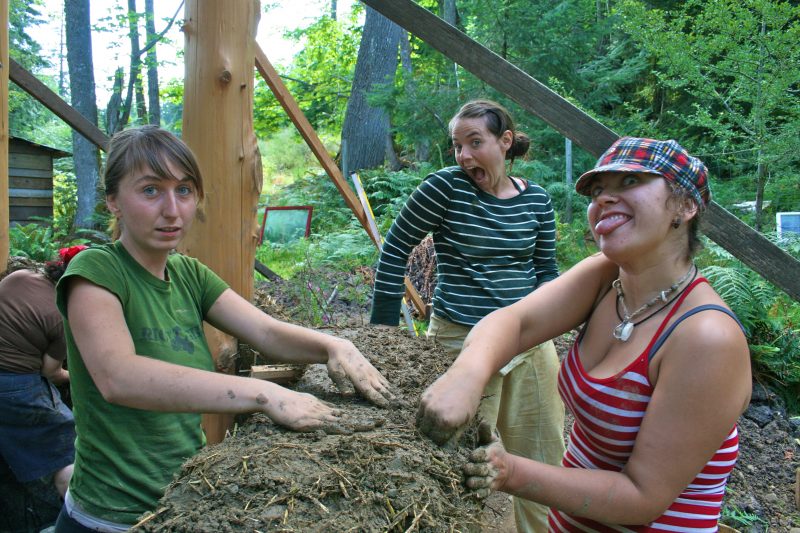
“We try to tell people to stop laughing and joking around. The struggle is real, people.” Brianna Walker photo.
They estimate they spend one third of their time together in meetings, including four or five day-long meetings at the beginning and end of each season, plus a daily morning “check-in.” They admit it’s not always fun but, “we definitely would not have the high level of trust, cohesivity, resilience, and butt cramps that we have, if it weren’t for the value we place on committed communication.” (p.107, parag.3)
Consensus and mutual respect are certainly admirable, but as a traditional carpenter I had to ask: who leads? On any job I’ve been on, it was the foreman’s (lead hand’s?) work to make all decisions – a vital part of moving every job along. The Mudgirls wrestled with this fact. They realize that when you’re working, you can’t call a meeting on the spot to discuss every simple decision, “like where to pile the sifted manure,” (p. 110, parag. 3) and they know that clients (more traditional than their builders in this case) expect “to have one person who looks and acts like the boss.” (p.112, parag.1) They resolved the dilemma by distinguishing between “leader” and “boss.” (p.112, parag.1) The answer, they decided – after much discussion and as part of their goal of seeking “new examples of organizing” – was a compromise (agreed to by all) that “encourages all crew members to make more effort to understand the bigger picture, and to give constructive feedback at check-ins.” (p.112-3, parag. 2)
For me, the best part of the book starts almost two-thirds of the way through when we get to the nitty-gritty. Here are the tantalizing details of how to actually build; here we learn some of the tricks of the trade like how to test clay to see if it’s suitable, how to mix cob and plasters. Here’s the importance of sheer vs. compressive strength, recipes for paints for plaster and mud, how and when to pick trees for post and beam building (in spring when the sap’s running so they’re easier to peel), and a list of essential tools.
I learned a lot from this book, including how to build a dry stack rock foundation, fix cracks in clay, and that a building made of natural materials, once allowed to dry, will not melt if it gets wet as long as the foundation is at least 18 inches off the ground and there’s a large overhang. (p.156) Did you know horse manure plaster makes a wonderful base coat for earthen structures and sculpting walls? Or that lime has an electromagnetic charge and likes to be applied on top of other lime? (p.147) Almost romantic – or am I starting to sound naïve?
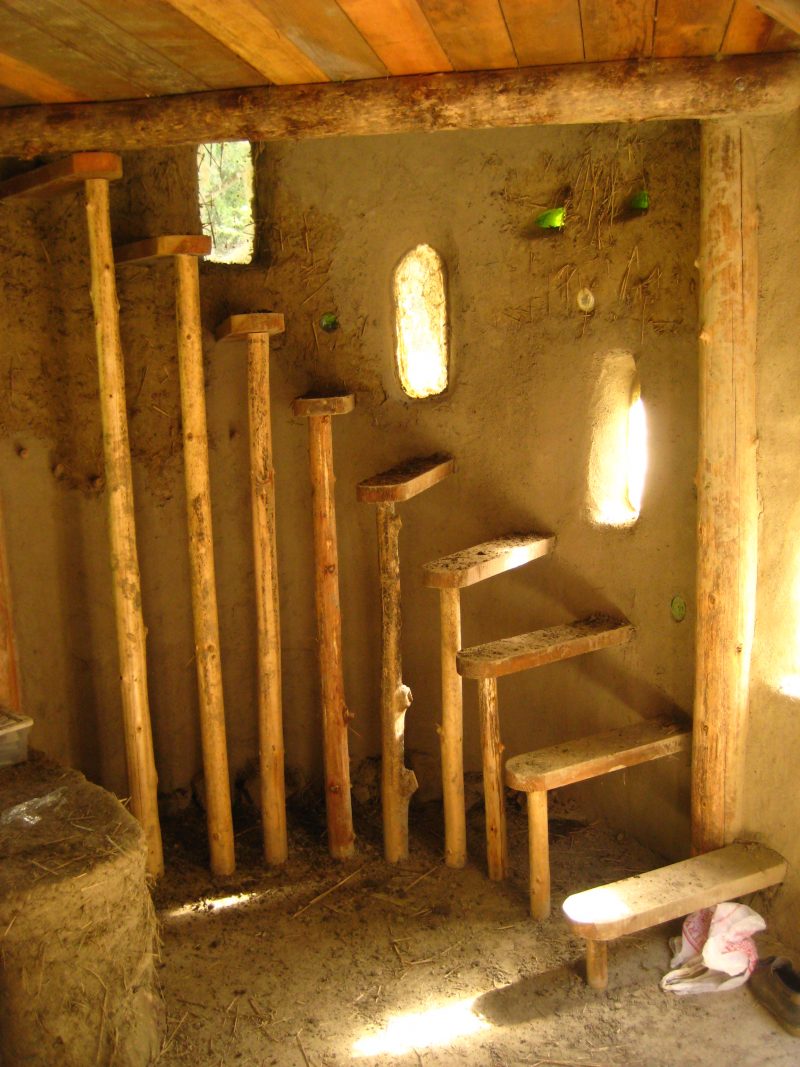 The Mudgirls point out that with mud and clay, there is an “inability to maintain complete control” over your materials, which leads, they say, “to a sense of wonder and trust in the process that can be wildly liberating.” (p.159, parag.3) And with that, I suddenly understand where some of my unease comes from; the whole focus of my trades training and practice was about control. That’s why traditional construction workers – carpenters, plumbers, ironworkers… all of us – are crazy about levels and squares (and sledgehammers, should materials refuse to cooperate). The thinking is that with everything perfectly plumb and square and straight (or as perfect as we can get it) that things won’t fall down. We build it “right,” which means complete control over every aspect of the building. It’s something I learned, and learned to be proud of.
The Mudgirls point out that with mud and clay, there is an “inability to maintain complete control” over your materials, which leads, they say, “to a sense of wonder and trust in the process that can be wildly liberating.” (p.159, parag.3) And with that, I suddenly understand where some of my unease comes from; the whole focus of my trades training and practice was about control. That’s why traditional construction workers – carpenters, plumbers, ironworkers… all of us – are crazy about levels and squares (and sledgehammers, should materials refuse to cooperate). The thinking is that with everything perfectly plumb and square and straight (or as perfect as we can get it) that things won’t fall down. We build it “right,” which means complete control over every aspect of the building. It’s something I learned, and learned to be proud of.
And yet…
Over fifteen years, it’s true, I got tired of those thousands of perfect ninety-degree angles, the absolute uniformity of 4’x8’ sheets of plywood and drywall. The Mudgirls are on to something, even from a traditional builder’s point of view. The body that’s building is still a body, and to see its curves reflected in the structures around it, would be lovely indeed. And all that mud and dirt so liberally spread across faces and hands in the book? It’s true, dirt is fun. Maybe we women never got enough of it when we were young.
And yet….
I’m uneasy about their disregard for traditional building skills – how do they cut rafters to sit straight, dig drainage ditches and set up plumbing to be sure water and waste easily flow away? But especially I worry about the lack of inspectors, of an experienced builder to give that impersonal double-check that assures a building is safe to live in. It doesn’t seem to worry the Mudgirls. As they put it, “The more we stayed under the radar, the less risk we’d have to compromise on anything.”
Safety is a huge issue in building, and the Mudgirls do address some concerns, mentioning hard hats, roof harnesses and the importance of safe ladders and scaffolding, though there’s not a single hard hat to be seen in the photos of people working (p.165, parag.2). But I’m most alarmed that they don’t seek out trained electricians. “Get some help wiring if you are scared,” they say (p.167, parag.1) but otherwise recommend getting your own wiring education from a book. I love books, but I wouldn’t dare to wire an entire house from one because poor wiring is such a serious fire hazard. But Mudgirls assert that regulations offer “a fictional sense of safety.” (p.169, Endnote 1, Chapter 1.)
And yet….
When I found myself quibbling in my own mind over some of their practices, I remember that the women’s goal is not just to practice alternative building, but to find and practice alternative “living, connecting, learning, and sharing.” (p.199, parag.3) “Transformation” is a Guiding Principle. (p.119, parag.1) “We make the decision over and over again,” they state, “to change the world, one bucket at a time.” (p.95, parag.1) And how else can we create real change in this competitive and violence-ridden world except through the passion of wildly determined optimists like these? Maybe more of us need to gather our courage, leap in, and try doing things a little differently, using the best parts of tradition – yes – but breaking free of what doesn’t and hasn’t worked so well for so many.
In the end, though I could have used less manifesto and more mud, the Mudgirls have my blessing. May their revolution continue – safely – to grow. Keep the spirit, sisters. Keep what has worked in the past, too – but keep it all safe!
*
Kate Braid worked for fifteen years as a construction labourer, apprentice and journey carpenter. She has written, co-written, edited and co-edited 14 books and chapbooks of non-fiction and prize-winning poetry. She lives in Victoria and on Pender Island. See www.katebraid.com
*
The Ormsby Review. More Books. More Reviews. More Often.
Reviews Editor: Richard Mackie
Reviews Publisher: Alan Twigg
The Ormsby Review is a journal service for serious coverage of B.C. books and authors, hosted by Simon Fraser University. The Advisory Board consists of Jean Barman, Robin Fisher, Cole Harris, Wade Davis, Hugh Johnston, Patricia Roy, David Stouck, and Graeme Wynn. Scholarly Patron: SFU Graduate Liberal Studies. Honorary Patron: Yosef Wosk.
“Only connect.” – E.M. Forster

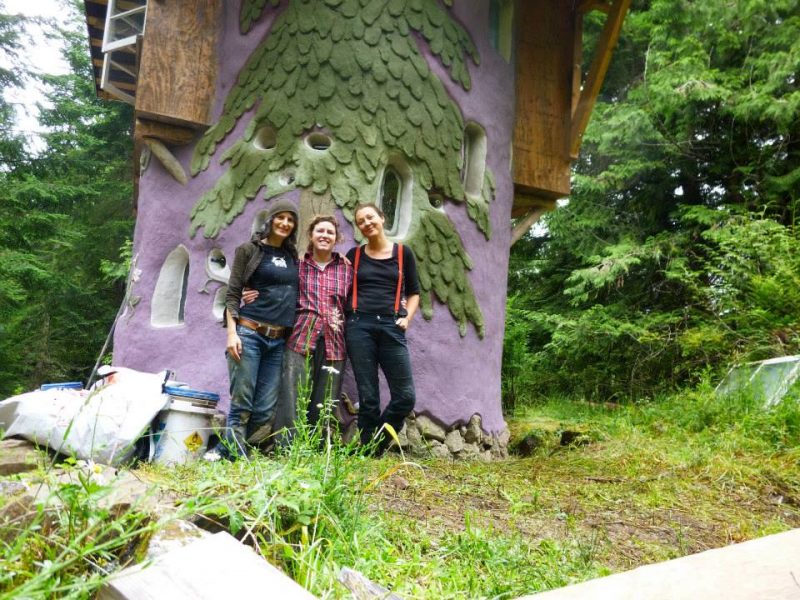
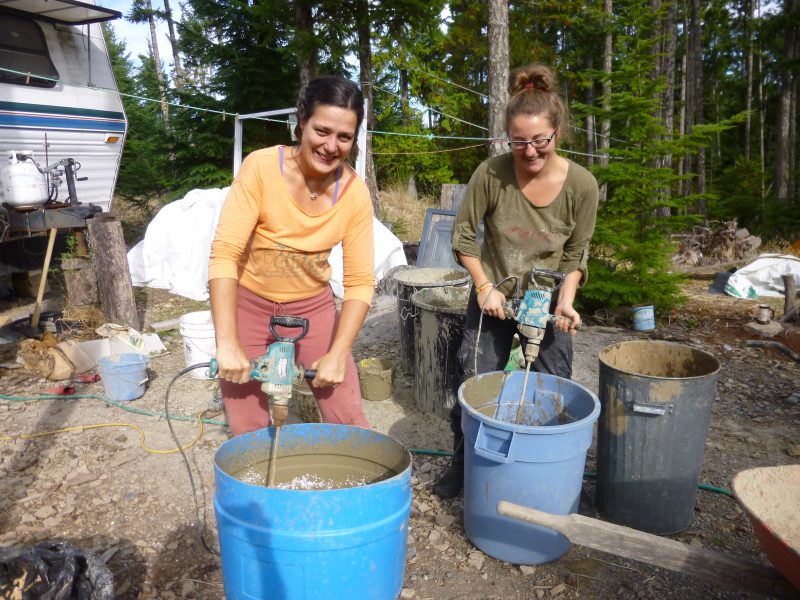

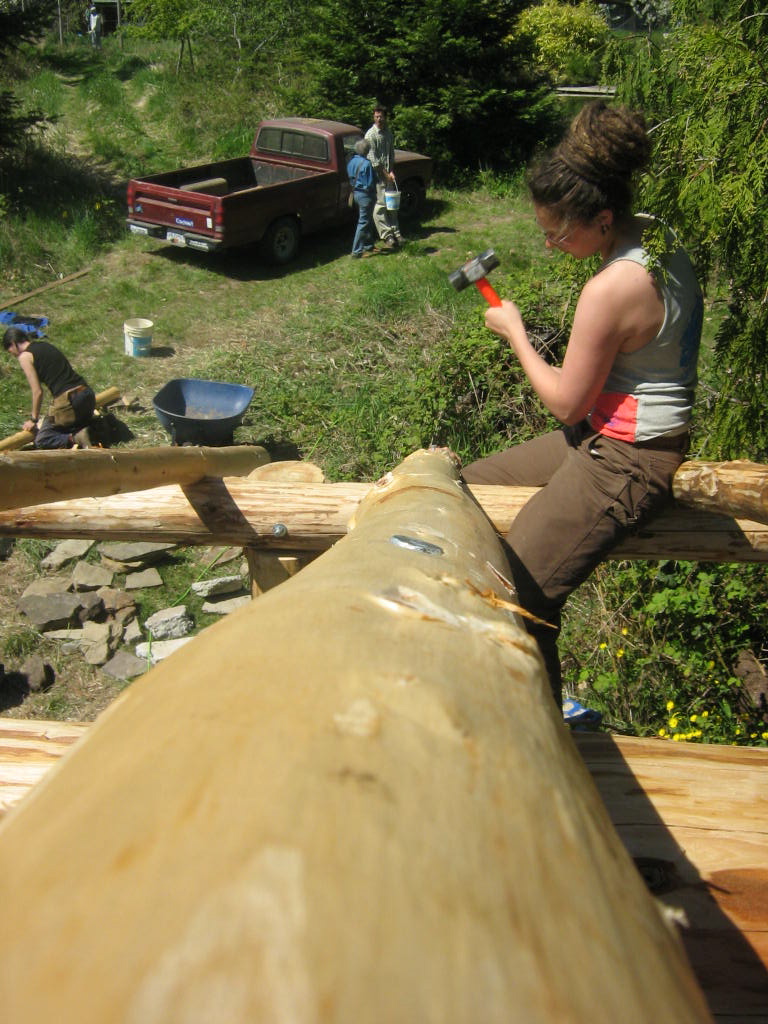



Leave a Reply